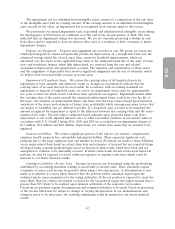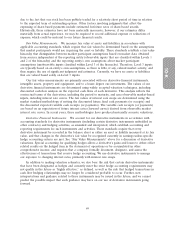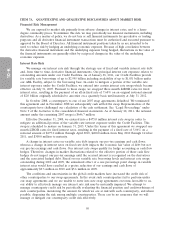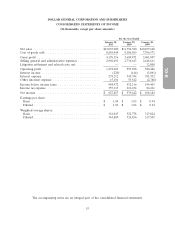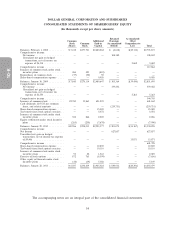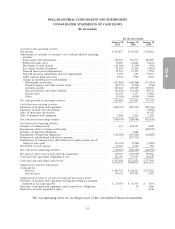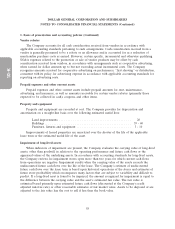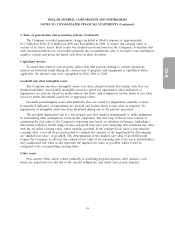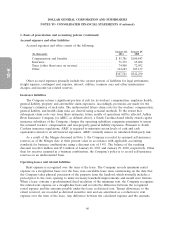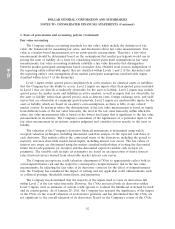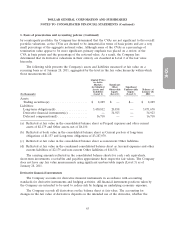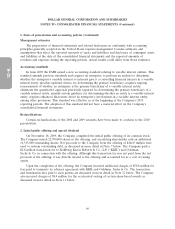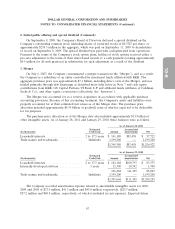Dollar General 2010 Annual Report Download - page 135
Download and view the complete annual report
Please find page 135 of the 2010 Dollar General annual report below. You can navigate through the pages in the report by either clicking on the pages listed below, or by using the keyword search tool below to find specific information within the annual report.
10-K
DOLLAR GENERAL CORPORATION AND SUBSIDIARIES
NOTES TO CONSOLIDATED FINANCIAL STATEMENTS (Continued)
1. Basis of presentation and accounting policies (Continued)
mutual funds held pursuant to deferred compensation and supplemental retirement plans, as further
discussed in Note 10) are stated at fair value, with changes in fair value recorded as a component of
Selling, general and administrative (‘‘SG&A’’) expense.
As of January 28, 2011 and January 29, 2010, the Company had investments in trading securities of
$8.3 million and $8.8 million, respectively, $2.2 million and $1.6 million of which were classified as
Prepaid expenses and other current assets, respectively, and $6.1 million and $7.2 million of which were
classified as Other assets, net, respectively, in the consolidated balance sheets. Historical cost
information pertaining to these investments in mutual funds by participants in the Company’s
supplemental retirement and compensation deferral plans is not readily available to the Company.
During 2008, the Company’s South Carolina-based wholly owned captive insurance subsidiary,
Ashley River Insurance Company (‘‘ARIC’’), had investments in various debt securities. These
investments were held pursuant to South Carolina regulatory requirements to maintain certain asset
balances related to ARIC’s liability and equity balances, which could have limited the Company’s ability
to use these assets for general corporate purposes. In May 2008, the state of South Carolina made
certain changes to these regulations, which in turn changed the Company’s investment requirements. As
a result, the Company reclassified certain investments held by ARIC from held-to-maturity to
available-for-sale, and ARIC subsequently liquidated certain investments totaling $48.6 million during
2008.
For the years ended January 28, 2011, January 29, 2010 and January 30, 2009, gross realized gains
and losses on the sales of available-for-sale securities were not material. The cost of securities sold is
based upon the specific identification method.
Merchandise inventories
Inventories are stated at the lower of cost or market with cost determined using the retail last-in,
first-out (‘‘LIFO’’) method as this method results in a better matching of costs and revenues. Under the
Company’s retail inventory method (‘‘RIM’’), the calculation of gross profit and the resulting valuation
of inventories at cost are computed by applying a calculated cost-to-retail inventory ratio to the retail
value of sales at a department level. Costs directly associated with warehousing and distribution are
capitalized into inventory. The excess of current cost over LIFO cost was approximately $52.8 million
and $47.5 million at January 28, 2011 and January 29, 2010, respectively. Current cost is determined
using the RIM on a first-in, first-out basis. Under the LIFO inventory method, the impacts of rising or
falling market price changes increase or decrease cost of sales (the LIFO provision or benefit). The
Company recorded a LIFO provision of $5.3 million in 2010, a LIFO benefit of $2.5 million in 2009,
and a LIFO provision of $43.9 million in 2008.
The 2008 LIFO provision was impacted by increased commodity costs related to food and pet
products which were driven by fruit and vegetable prices and rising freight costs. In addition, increases
in petroleum, resin, metals, pulp and other raw material commodity costs also resulted in multiple
product cost increases. These trends generally stabilized or reversed in 2009 and 2010.
57


